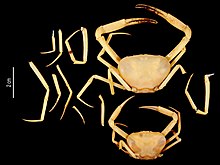
The Mexican tetra, also known as the blind cave fish, blind cave characin or the blind cave tetra, is a freshwater fish in the Characidae family of the order Characiformes. The type species of its genus, it is native to the Nearctic realm, originating in the lower Rio Grande, and the Neueces and Pecos Rivers in Texas, into the Central Plateau and eastern states of Mexico.

The Amblyopsidae are a fish family commonly referred to as cavefish, blindfish, or swampfish. They are small freshwater fish found in the dark environments of caves, springs and swamps in the eastern half of the United States. Like other troglobites, most amblyopsids exhibit adaptations to these dark environments, including the lack of functional eyes and the absence of pigmentation. More than 200 species of cavefishes are known, but only six of these are in the family Amblyopsidae. One of these, Forbesichthys agassizii, spends time both underground and aboveground. A seventh species in this family, Chologaster cornuta, is not a cave-dweller but lives in aboveground swamps.

A subterranean river is a river or watercourse that runs wholly or partly beneath the ground, one where the riverbed does not represent the surface of the Earth. It is distinct from an aquifer, which may flow like a river but is contained within a permeable layer of rock or other unconsolidated materials. A river flowing below ground level in an open gorge is not classed as subterranean.
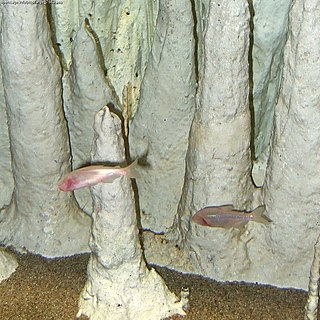
Stygofauna are any fauna that live in groundwater systems or aquifers, such as caves, fissures and vugs. Stygofauna and troglofauna are the two types of subterranean fauna. Both are associated with subterranean environments – stygofauna are associated with water, and troglofauna with caves and spaces above the water table. Stygofauna can live within freshwater aquifers and within the pore spaces of limestone, calcrete or laterite, whilst larger animals can be found in cave waters and wells. Stygofaunal animals, like troglofauna, are divided into three groups based on their life history - stygophiles, stygoxenes, and stygobites.
- Stygophiles inhabit both surface and subterranean aquatic environments, but are not necessarily restricted to either.
- Stygoxenes are like stygophiles, except they are defined as accidental or occasional presence in subterranean waters. Stygophiles and stygoxenes may live for part of their lives in caves, but don't complete their life cycle in them.
- Stygobites are obligate, or strictly subterranean, aquatic animals and complete their entire life in this environment.

Orconectes is a genus of cave dwelling freshwater crayfish, endemic to suitable habitats in the eastern United States. Surface dwelling species, formerly categorised here, were moved to Faxonius in 2017.
Caecobarbus geertsi, the African blind barb or Congo blind barb, is a species of cyprinid fish. This threatened cavefish is only known from Democratic Republic of the Congo, and it is the only member of the monotypic genus Caecobarbus. George Albert Boulenger described this fish in 1921 and it apparently lacks any close relatives in the Congo region.
Garra typhlops, also known as the Iran cave barb is a species of ray-finned fish in the family Cyprinidae. It is endemic to caves in Iran. Like other cave-adapted fish, it is blind and lacks pigmentation.
The Georgia blind salamander is a species of salamander in the family Plethodontidae. It is endemic to the south-eastern United States where its natural habitats are inland karsts, caves and subterranean habitats. It is listed as "Endangered" by the IUCN and is threatened by habitat loss.

The blind cave eel is a species of cavefish in the family Synbranchidae. It is the longest cavefish in Australia and one of the only three vertebrates in Australia that is restricted to underground waters, the other being the blind gudgeon and the Barrow cave gudgeon. It is blind, its body is eel-like and elongated, and it has a non-pigmented skin with colours ranging from white to pink.
Stygichthys typhlops, the blind tetra or Brazilian blind characid, is a species of fish in the family Characidae and the only member of the genus Stygichthys. It is endemic to caves in northern Minas Gerais, Brazil. Like other cave-adapted fish, the Brazilian blind characid is blind and lacks pigmentation. It reaches up to about 4.6 cm (1.8 in) in standard length. It is solitary and when kept together in an aquarium, individuals are indifferent to each other.
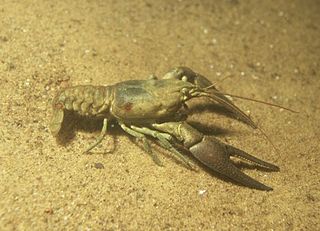
Cambarus aculabrum is a rare species of cave-dwelling crayfish known by the common name Benton county cave crayfish. It is native to Arkansas in the United States, where it is known from only four locations. It is a federally listed endangered species of the United States.

Procambarus is a genus of crayfish in the family Cambaridae, all native to North and Central America. It includes a number of troglobitic species, and the marbled crayfish (marmorkrebs), which is parthenogenetic. Originally described as a subgenus for four species, it now contains around 161 species.

Cavefish or cave fish is a generic term for fresh and brackish water fish adapted to life in caves and other underground habitats. Related terms are subterranean fish, troglomorphic fish, troglobitic fish, stygobitic fish, phreatic fish, and hypogean fish.
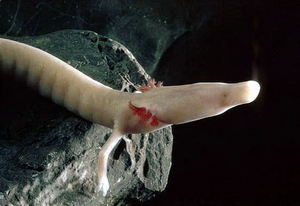
A cave salamander is a type of salamander that primarily or exclusively inhabits caves, a group that includes several species. Some of these animals have developed special, even extreme, adaptations to their subterranean environments. Some species have only rudimentary eyes. Others lack pigmentation, rendering them a pale yellowish or pinkish color.

Cancrocaeca xenomorpha is a species of troglobitic (cave-dwelling) freshwater crab from Sulawesi, the only species in the monotypic genus Cancrocaeca. It has been described as the world's "most highly cave-adapted species of crab".
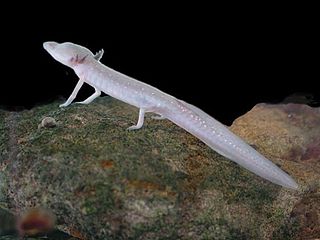
Troglomorphism is the morphological adaptation of an animal to living in the constant darkness of caves, characterised by features such as loss of pigment, reduced eyesight or blindness, and frequently with attenuated bodies or appendages. The terms troglobitic, stygobitic, stygofauna, troglofauna, and hypogean or hypogeic, are often used for cave-dwelling organisms.
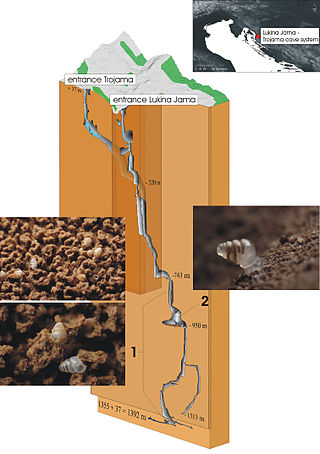
Biospeleology, also known as cave biology, is a branch of biology dedicated to the study of organisms that live in caves and are collectively referred to as troglofauna.
Parveen F. Absar is a wildlife biologist from India. In 2017, she was credited with the discovery of a species of freshwater crab called Teretamon absarum, of the genus Teretamon and species speleaum.
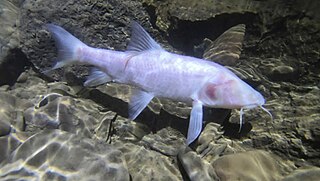
Neolissochilus pnar is a species of subterranean cyprinid in the genus Neolissochilus. It is the largest known subterranean fish, a title formerly held by the blind cave eel.

